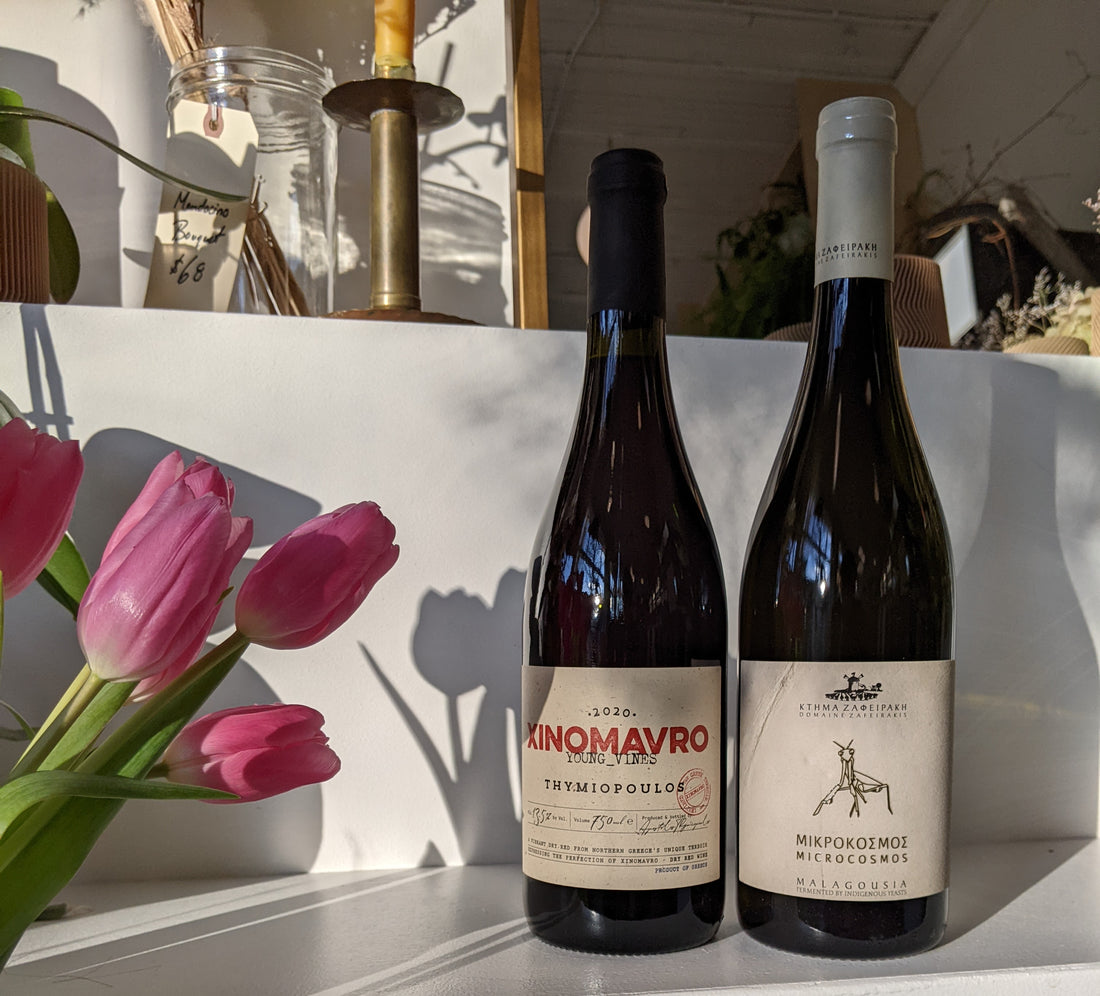
November 2021 - Mainland Greece
November 2021
Mainland Greece
Featuring:
Domaine Zafeirakis, Malagousia, Tyrnavos 2020
Thymiopoulos, ‘Young Vines’ Xinomavro 2020
At a glance:
- Celebrating a four millenia winemaking history
- The country can be divided into four major regions and climates - the North (along the border), Central (around Athens), Peninsular (Peloponnese), and the Islands (Aegeans and Crete)
- While Greek reds can be incredible, it’s one of the few countries where white wines really dominate the conversation
- Host to a number of unique winemaking and growing styles, including the famous ‘kouloura’ aka basket-vines of Santorini and the pine-resin aging of Retsina
While the Republic of Georgia may have the longest wine producing history, we owe it to the Greeks for exporting their love affair with the grape practically the world over (by way of Western Europe, of course). This country, with a 4000 year history, was responsible for scattering olives and grapevines across the Mediterranean and Northern Africa. And while they have an incredibly long wine history, they also have one of the most misunderstood.
For the better part of the last century, Greek wine wasn’t thought of as much more than cheap white wine and offensive, pine-flavored Retsina that would always play second-fiddle to the greater wines of Italy, France, and Spain. However, in the last 30 years, thanks to some amazing winemakers on both the mainland and the islands, we’ve seen a renaissance in the quality and precision of Greek grapes. Today you can find wonderful high-acid, salty white wines, deep and brooding reds with focus and precision, and even good Retsina. This month we’ll explore just two of the many producers responsible for the new gilded age of Greek wines.
Domaine Zafeirakis, Malagousia, Tyrnavos 2020
While Christos Zafeirakis may have spent his childhood amongst his family’s grape vine holdings, he wasn’t raised in a winemaking family per se. Like many Greek families, the Zafeirakis’ tended grapes and sold them to the local co-op, which in turn gave them some table wine to consume and trade with friends. Young Christos, however, saw the potential for a more robust legacy and wanted to establish a true family estate. After traveling to Italy (Tuscany, Piedmont, and Alto Adige) to study under several winemakers, he returned back to Greece to found Domaine Zafeirakis.
By 2005 Christos had established the first organic vineyard in the region and expanded the family’s holdings to 8 hectares (roughly 20 acres). He’s also credited with preserving and restoring the native variety Limniona, which was nearly extinct due to the phylloxera epidemic decades earlier. Malagousia, which we have in the club this month, was another variety that was nearing extinction and while a different winery ultimately saved that grape, it’s still importantly championed by Zafeirakis.
The estate is just north of the region’s capital, Larissa. Further north, one finds the mythical Mount Olympus - famous in Greek Mythology the world over. Here, the soil is intensely clay dominated, with a high amount of calcium and mineral deposits due to the ancient rivers that ran through this area. As mentioned before, Zafeirakis farms entirely organically and manages all his own vineyards himself. The winemaking is simple and straightforward. Grapes are gently pressed and the juice is fermented in large stainless steel vats. It continues to age in the stainless steel for 6 months (to preserve freshness and limit oxidation) and then is bottled with a small amount of sulfur dioxide to stabilize the wine for export or storage.
It is a wonderful Aperitif wine that would be great on it’s own or with anything salty or tangy - crunchy greek salad, grilled fish or roasted chicken.
Thymiopoulos, ‘Young Vines’ Xinomavro 2020
Apostolos Thymiopoulos is another first-in-the-family winemaker and a de facto face of the new generation in Greece. A native of Naoussa, Apostolos grew up with family vineyards that were sold to larger growers. He saw these being conventionally farmed and was determined how to both treat his family’s land better. Upon completion of winemaking school at the University of Athens, he returned home to found Thymiopoulos Vineyards.
His first wine was called ‘Ghi kai Uranos’ (Earth & Sky), hinting at his belief in the connection between a larger realm responsible for the production of great wine. This wine was based off of Xinomavro (Zee-no-mavro), which was relatively unknown internationally at the time. Today, Xinomavro is the best-known Greek red and is capable of producing appealing wines - ranging from juicy and light, to firm and tannic, and everything in between. Thymiopolis sources their best grapes from their home vineyards in the village of Trilofos, directly west of Thessaloniki, and also has holdings in nearby Rapsini. (Using Mount Olympus, again, we are just a bit due North now)
While Apolostolo makes a large number of wines from other grapes, his main love affair still lies with Xinomavro. This month’s expression from his is famously known as the ‘Young Vines’ and while there are a few people doing this now, he was undoubtedly the first. The logic is thus - Xinomavro can be a full and intensely tannic grape that doesn’t lend itself to easy drinking without some age. However when the vines are rather young (under 10 years), they tend to produce a wine with less structural intensity, so this version of Xinomavro is capable of being juicy and coiffable.
Apostolo started making this Young Vine cuvee just about a decade ago, and as you can guess, the original vines had aged to be less and less young overtime. Eventually he became displeased with the structure the original vines were producing so he planted some new vineyards and moved the other production over to his other cuvees of Xinomavro. This vintage, 2020, is the first fruit off these new vines, so we are officially back to drinking the youngest of young vines that Thymioupolis can give us.
The grapes are hand harvested with 75% of them being fully destemmed, and then fermented in stainless steel. After fermentation is complete, they’re pressed off to age in concrete eggs for 8 months before bottling. The result is a wonderfully drinkable red that still has an element of spice and structure to it in addition to the fresh red fruits, grass, and wild herbs. Drink this with grilled proteins - lamb is an obvious choice but beef, pork, or vegan options would be good too.
